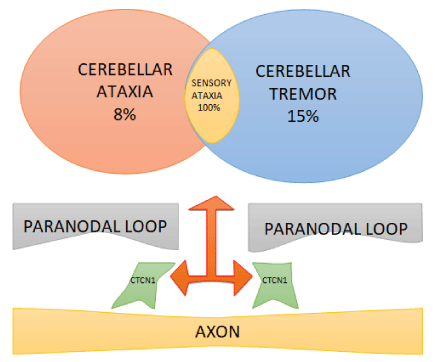J Neurol Neurol Sci Disord
CIDP in elderly patients with sensory ataxia: Never forget to think about Contactin 1 spectrum
Marcus Vinícius Magno Gonçalves1*, André Eduardo de Almeida Franzoi2, Rinaldo Claudino3 and Osvaldo Nascimento4
2Medical student - Department of Medicine, University of the Region of Joinville (UNIVILLE), Brazil
3Neurology, Neuromed - Florianopolis, Brazil
4Professor of Neurology, UFF - Rio de Janeiro, Brazil
Cite this as
Magno Gonçalves MV, de Almeida Franzoi AE, Claudino R, Nascimento O (2019) CIDP in elderly patients with sensory ataxia: Never forget to think about Contactin 1 spectrum. J Neurol Neurol Sci Disord 5(1): 006-007. DOI: 10.17352/jnnsd.0000027Chronic inflammatory demyelinating polyneuropathy (CIDP) is an acquired disorder of peripheral nerves. Paranodal axoglial junctions formed by the association of contactin-1 (CNTN1), contactin-associated protein 1 (CASPR), and neurofascin-155 (NF-115) play important functions in nerve impulse propagation along myelinated axons. As with neurofascin antibody-mediated CIDP, this condition may be responsive to B cell depletion therapy (anti-CD20 therapies) and refractory to intravenous immune globulin. CTCN1 antibody is an IgG4 subclass and pathophysiologically does not activate complement pathways. It justifies the poor response to intravenous immunoglobulin and possibly a better response to anti-CD20 therapies. We believe that CTCN1 antibodies may be useful as a clinical diagnostic and therapeutic response immunometric biomarker in elderly patients with CIDP and sensory ataxia.
Chronic inflammatory demyelinating polyneuropathy (CIDP, also known as chronic inflammatory demyelinating polyradiculoneuropathy) is an acquired disorder of peripheral nerves and nerve roots. Whether CIDP is a disease or a syndrome remains controversial. CIDP is the most frequent chronic inflammatory neuropathy. Diagnosis is based on clinical features supported by electromyographical findings. CIDP comprises a heterogeneous group of clinical phenotypes [1].
The immunologic causes of most forms of CIDP remain unclear, since specific provoking antigens have not previously been identified. However, antibodies to different isoforms of neurofascin or to contactin have been detected in patients with CIDP [1,2].
Paranodal axoglial junctions formed by the association of contactin-1 (CNTN1), contactin-associated protein 1 (CASPR), and neurofascin-155 (NF-115) play important functions in nerve impulse propagation along myelinated axons. To optimize nerve conduction and prevent current leakages, neurofascin 155, CNTN1 and CASPR establish the axon glial junction separating nodal voltage-gated sodium channels from juxtaparanodal voltage-gated Kv1 channels [1,2].
Neurofascin and contactin are critical structural elements of the paranodal loop attachment to the axolemma. The antibodies identified are in the IgG4 subclass. These antibodies appear to target paranodal proteins and may disrupt the axonal-glial junctions, leading to nerve conduction slowing. Compared with antibody-negative CIDP, patients with NF155 antibody-mediated CIDP are more likely to have sensory ataxia and prominent tremor. The symptoms can cause severe dysfunction [1,2].
Autoantibodies of the IgG4 class to contactin 1 are found in a small subset of patients with CIDP. The clinical phenotype is not fully established but is often severe and predominantly motor with early axonal involvement. As with neurofascin antibody-mediated CIDP, this condition may be responsive to B cell depletion therapy and refractory to intravenous immune globulin therapy [1,2].
Autoantibodies IgG4 to contactin-1 and neurofascin-155 are IgG4 antibodies subclass. The IgG4 subclass is a relatively rare antibody subset with unique properties. The concentration of IgG4 in healthy adult blood is 0.08–1.4 g/L, which represents approximately 5% of the total IgG pool. IgG4 differs from other IgG subclasses in several structural and functional aspects amongst them IgG4 cannot activate complement, because it is unable to bind the first complement cascade component C1q [3,4].
Autoantibodies IgG4 to contactin-1 and neurofascin-155 define CIDP with disabling cerebellar tremor, poor response to intravenous immunoglobulin (IgIV) and the remarkably increased protein level cerebrospinal fluid [5]. These antibodies appear to loosen the paranodal barrier, thereby favouring antibody progression and causing paranodal collapse [6].
Querol L et al. evaluated 46 sera from patients with CIDP. Reactivity against CNTN1 was confirmed in 2 cases. The patients shared common clinical features, including advanced age, predominantly motor involvement, aggressive symptom onset, early axonal involvement and poor response to intravenous immunoglobulin [7].
Miura Y et al. described the clinical and serological features of Japanese with CIDP. 13 of 533 (2.4%) patients were anti-contactin 1 IgG4 positive whereas neither patients from disease or normal control subjects did (P = 0.02). 3 of 13 (23%) patients showed subacute symptom onset, 1 of 13 (8%) showed cerebellar ataxia, and 2 (15%) showed tremor. However, all of the patients (100%) presented with sensory ataxia and elderly onset (100%). Six of 10 (60%) anti-contactin 1 antibody-positive patients had poor response to intravenous immunoglobulin. We illustrated this data in figure 1 [8].
CTCN1 antibodies may be useful as a clinical diagnostic and therapeutic response immunometric biomarker in elderly patients with CIDP and sensory ataxia. CTCN1 antibody is an IgG4 subclass and pathophysiologically does not activate complement pathways. It justifies the poor response to intravenous immunoglobulin and possibly a better response to anti-CD20 therapies.5
The identification of antigenic targets and the corresponding IgG subclass of the autoantibody leave us wondering whether a specific treatment might be applicable. The exact effect of anti-CD20 in IgG4 diseases is unknown. However, apparently the destruction of pro-B cells reduces antibody titers and symptoms significantly [9].
In elderly patients who meet the criteria to CIDP featuring with sensory ataxia, the CTCN1 dosage should be considered. Our hypothesis is the positivity in CTCN1 dosage could help in a better therapeutic choice, aiming to optimize the therapeutic window by the marked degree of axonal loss in the evolution of this disease.
Disclosure
The authors report no disclosures. Gonçalves MVM reports no disclosures, Franzoi AEA reports no disclosures, Claudino R reports no disclosures, and Nascimento O reports no disclosures.
- Fujita A (2018) Parallel fluctuation of anti-neurofascin 155 antibody levels with clinico-electrophysiological findings in patients with chronic inflammatory demyelinating polyradiculoneuropathy. J Neurol Sci 384: 107-112. Link: https://tinyurl.com/y2soymlv
- Doppler K (2018) Neurofascin-155 IgM autoantibodies in patients with inflammatory neuropathies. J Neurol Neurosurg Psychiatry 89: 1145-1151. Link: https://tinyurl.com/yx9odh7r
- Grimaldi LM (1986) IgG1,3 and 4 oligoclonal bands in multiple sclerosis and other neurological diseases. Ital J Neurol Sci 7: 507-513. Link: https://tinyurl.com/yxjdcz3x
- Kira JI, Yamasaki R, Ogata H (2018) Anti-neurofascin autoantibody and demyelination. Neurochem Int 18: S0197-0186. Link: https://tinyurl.com/y3sy58so
- Kuwabara S, Misawa S, Mori M (2017) Nodopathy: chronic inflammatory demyelinating polyneuropathy with anti-neurofascin 155 antibodies. J Neurol Neurosurg Psychiatry 88: 459. Link: https://tinyurl.com/y6m5jjo2
- Manso C (2016) Contactin-1 IgG4 antibodies cause paranode dismantling and conduction defects. Brain 139: 1700-1712. Link: https://tinyurl.com/yxlfxmcr
- Querol L (2013) Antibodies to contactin-1 in chronic inflammatory demyelinating polyneuropathy. Ann Neurol 73: 370-380. Link: https://tinyurl.com/y3mgzw6w
- Miura Y (2015) Contactin 1 IgG4 associates to chronic inflammatory demyelinating polyneuropathy with sensory ataxia. Brain 138: 1484-1491. Link: https://tinyurl.com/y2dptzgq
- Buc M (2018) New biological agents in the treatment of multiple sclerosis. Bratisl Lek Listy 119: 191-197. Link: https://tinyurl.com/yxze3hwd
Article Alerts
Subscribe to our articles alerts and stay tuned.
 This work is licensed under a Creative Commons Attribution 4.0 International License.
This work is licensed under a Creative Commons Attribution 4.0 International License.


 Save to Mendeley
Save to Mendeley
